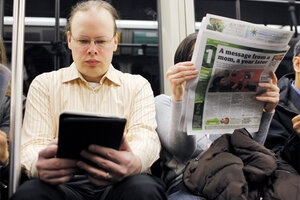What books sell best? Self-help, kid lit, and erotica
As USA Today celebrates the 20th anniversary of its bestseller list, the organization says romance novels, children's books, and inspirational books defined the last two decades of reading.

A commuter uses an e-reader on a subway train in Cambridge, Mass.
Brian Snyder/Reuters
Self-help, kid lit, and erotica: That, in a nutshell, sums up the last 20 years of bestselling books, according to a new analysis by USA Today.
The news organization is commemorating its 20-year anniversary of the USA Today bestseller list – which began in 1993 – by considering the major trends that have changed the publishing world in the last two decades.
The bottom line: the last two decades have been a period of dynamic change.
Broadly, three major eras have defined the retail book biz over the last 20 years: brick-and-mortar bookstores (1993-1998), online booksellers such as Amazon (1999-2008), and the rise of e-books (2009-present).
The rise of the latter two eras have had a significant impact on the publishing world, resulting in the shuttering of bookstores and entire bookstore chains, and ultimately changing the way we read.
The types of books Americans are reading has also undergone a significant shift in the last 20 years, according to USA Today’s analysis of its bestselling books. Broken down by era, popular genres have included:
• Self-help, inspiration, and advice books, which were popular between 1993-1998. Nine of the 25 most popular books from that era were self-help, according to the news organization. Among the bestsellers were John Gray’s “Men are from Mars, Women Are from Venus,” Richard Carlson’s “Don’t Sweat the Small Stuff,” and Jack Canfield and Mark Victor Hansen’s “Chicken Soup for the Soul.”
• Kid lit, which defined the publishing world from 1999-2008, and continues to exert significant influence in the book world today. Eleven of the 25 most popular books since 2009 are series aimed at kids or teens, according to the paper’s analysis. Among the children and teen books that have redefined the book biz are J.K. Rowling’s “Harry Potter” series, Suzanne Collins’s “Hunger Games” series, and Stephanie Meyer’s “Twilight” series.
• Erotica and romance, which have moved into the mainstream as e-books have enabled readers to consume the books in public more privately. Consider this: between 1994 and 2008, romance accounted for 5 percent to 9 percent of bestsellers. In 2012, it accounted for a whopping 25 percent of bestsellers tracked by USA Today. That’s thanks in large part to the book that has revolutionized romance and launched erotica into the mainstream: EL James’s “Fifty Shades of Grey.”
More takeaways from USA Today: Rowling has helped redefine reading when the hit “Harry Potter” series “triggered Dickens-like excitement about reading and demolished the conventional wisdom about children’s books.”
What’s more, since 2009 fiction has risen to all-time highs as readers look for an escape, perhaps from a grimmer world of recession, overseas conflicts, and government ineptitude.
Formerly pooh-poohed, translations have also become hot business in books. Doubters have only to remember the success of Swedish reporter Stieg Larsson’s “The Girl With the Dragon Tattoo” and other books in the Milennium trilogy.
Two other factors that have had a major impact on books sales in the last 20 years, one growing, one waning: Hollywood and Oprah. As USA Today wrote, “Nothing sells a book like a movie adaption.” That goes for the likes of Rowling, Collins, Dan Brown, John Grisham, and Nicholas Sparks, all of whom have enjoyed a boost in sales when their novels were adapted for the big screen.
As for Oprah, her influence reigned supreme during her book club’s heyday between 1996 and 2001, when each of her 72 book club picks, including Jonathan Franzen’s “Freedom,” made multiple bestseller lists.
(Surprisingly, however, the “Oprah Effect” was limited to just a few weeks of big sales, the paper reports. “Not one of Oprah’s picks was the top seller for the year,” USA Today writes. “None appear in the top 25 books of each era.”)
Whether readers are getting self-help from a brick-and-mortar store, “Harry Potter” from Amazon, or “Fifty Shades” on an e-reader, one thing hasn’t changed: bestsellers have always been a cultural touchstone.
“A mega bestseller works itself into the social fabric of our lives,” Paul Bogaards, publicity director of Knopf and Doubleday, told USA Today. “It becomes part of the American culture. Everyone knows Harry Potter even if they’ve never read any of the books.”
Husna Haq is a Monitor correspondent.

